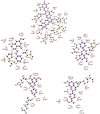Exploring the 3,5-Dibromo-4,6-dimethoxychalcones and Their Flavone Derivatives as Dual α-Glucosidase and α-Amylase Inhibitors with Antioxidant and Anticancer Potential
- PMID: 39456508
- PMCID: PMC11505200
- DOI: 10.3390/antiox13101255
Exploring the 3,5-Dibromo-4,6-dimethoxychalcones and Their Flavone Derivatives as Dual α-Glucosidase and α-Amylase Inhibitors with Antioxidant and Anticancer Potential
Abstract
The rising levels of type 2 diabetes mellitus (T2DM) and the poor medical effects of the commercially available antidiabetic drugs necessitate the development of potent analogs to treat this multifactorial metabolic disorder. It has been demonstrated that targeting two or more biochemical targets associated with the onset and progression of diabetes along with oxidative stress and/or cancer could be a significant strategy for treating complications related to this metabolic disorder. The 3,5-dibromo-4,6-dimethoxychalcones (2a-f) and the corresponding flavone derivatives (3a-f) were synthesized and characterized using spectroscopic (NMR, HR-MS and FT-IR) techniques. The inhibitory effect of both series of compounds against α-glucosidase and α-amylase was evaluated in vitro through enzymatic assays. Selected compounds were also evaluated for potential to activate or inhibit superoxide dismutase. Compound 3c was selected as a representative model for the flavone series and evaluated spectrophotometrically for potential to coordinate Cu(II) and/or Zn(II) ions implicated in the metal-catalyzed free radical generation. A plausible mechanism for metal-chelation of the test compounds is presented. Furthermore, the most active compounds from each series against the test carbohydrate-hydrolyzing enzymes were selected and evaluated for their antigrowth effect on the human breast (MCF-7) and lung (A549) cancer cell lines and for cytotoxicity against the African Green Monkey kidney (Vero) cell line. The parent chalcone 2a and flavone derivatives 3a, 3c and 3e exhibited relatively high inhibitory activity against the MCF-7 cells with IC50 values of 4.12 ± 0.55, 8.50 ± 0.82, 5.10 ± 0.61 and 6.96 ± 0.66 μM, respectively. The chalcones 2a and 2c exhibited significant cytotoxicity against the A549 cells with IC50 values of 7.40 ± 0.67 and 9.68 ± 0.80 μM, respectively. Only flavone 3c exhibited relatively strong and comparable cytotoxicity against the MCF-7 and A549 cell lines with IC50 values of 6.96 ± 0.66 and 6.42 ± 0.79 μM, respectively. Both series of compounds exhibited strong activity against the MCF-7 and A549 cell lines compared to the analogous quercetin (IC50 = 35.40 ± 1.78 and 35.38 ± 1.78 μM, respectively) though moderate compared to nintedanib (IC50 = 0.53 ± 0.11 and 0.74 ± 0.15 μM, respectively). The test compounds generally exhibited reduced cytotoxicity against the Vero cells compared to this anticancer drug. Molecular docking revealed strong alignment of the test compounds with the enzyme backbone to engage in hydrogen bonding interaction/s and hydrophobic contacts with the residues in the active sites of α-glucosidase and α-amylase. The test compounds possess favorable drug-likeness properties, supporting their potential as therapeutic candidates against T2DM.
Keywords: 3,5-dibromo-4,6-dimethoxychalcones; 6,8-dibromo-5,7-dimethoxyflavones; antioxidant activity; carbohydrate-hydrolyzing enzymes; cytotoxicity; molecular docking.
Conflict of interest statement
The authors declare no conflicts of interest.
Figures







Similar articles
-
In Vitro α-Glucosidase and α-Amylase Inhibition, Cytotoxicity and Free Radical Scavenging Profiling of the 6-Halogeno and Mixed 6,8-Dihalogenated 2-Aryl-4-methyl-1,2-dihydroquinazoline 3-Oxides.Antioxidants (Basel). 2023 Nov 6;12(11):1971. doi: 10.3390/antiox12111971. Antioxidants (Basel). 2023. PMID: 38001824 Free PMC article.
-
Synthesis and Evaluation of 1,3,5-Triaryl-2-Pyrazoline Derivatives as Potent Dual Inhibitors of Urease and α-Glucosidase Together with Their Cytotoxic, Molecular Modeling and Drug-Likeness Studies.ACS Omega. 2022 Jan 20;7(4):3775-3795. doi: 10.1021/acsomega.1c06694. eCollection 2022 Feb 1. ACS Omega. 2022. PMID: 35128286 Free PMC article.
-
Synthesis, Molecular Docking, and Bioactivity Study of Novel Hybrid Benzimidazole Urea Derivatives: A Promising α-Amylase and α-Glucosidase Inhibitor Candidate with Antioxidant Activity.Pharmaceutics. 2023 Jan 30;15(2):457. doi: 10.3390/pharmaceutics15020457. Pharmaceutics. 2023. PMID: 36839780 Free PMC article.
-
Amide linked chalcone derivatives, a promising class of compounds with versatile biological effects.RSC Adv. 2025 Jun 5;15(24):19043-19068. doi: 10.1039/d5ra00834d. eCollection 2025 Jun 4. RSC Adv. 2025. PMID: 40476228 Free PMC article. Review.
-
Inhibitors of Myocyte Triacylglyceride Accumulation.2013 Dec 15 [updated 2015 Feb 11]. In: Probe Reports from the NIH Molecular Libraries Program [Internet]. Bethesda (MD): National Center for Biotechnology Information (US); 2010–. 2013 Dec 15 [updated 2015 Feb 11]. In: Probe Reports from the NIH Molecular Libraries Program [Internet]. Bethesda (MD): National Center for Biotechnology Information (US); 2010–. PMID: 25834892 Free Books & Documents. Review.
Cited by
-
Structural Characterization and Bioactivity Evaluation of Selenium-Modified Dihydromyricetin from Vine Tea.Foods. 2025 May 13;14(10):1735. doi: 10.3390/foods14101735. Foods. 2025. PMID: 40428515 Free PMC article.
-
Research Progress on the Structure-activity Relationship and Mechanism of Flavonoid Derivatives in the Treatment of Lung Cancer.Molecules. 2025 Apr 18;30(8):1827. doi: 10.3390/molecules30081827. Molecules. 2025. PMID: 40333837 Free PMC article. Review.
-
In Vitro Enzymatic and Computational Assessments of Pyrazole-Isatin and Pyrazole-Indole Conjugates as Anti-Diabetic, Anti-Arthritic, and Anti-Inflammatory Agents.Pharmaceutics. 2025 Feb 23;17(3):293. doi: 10.3390/pharmaceutics17030293. Pharmaceutics. 2025. PMID: 40142957 Free PMC article.
References
-
- Chaudhury A., Duvoor C., Dendi V.S.R., Kraleti S., Chada A., Ravilla R., Marco A., Shekhawat N.S., Montales M.T., Kuriakose K., et al. Clinical review of antidiabetic drugs: Implications for type 2 diabetes mellitus, management. Front. Endocrinol. 2017;8:6. doi: 10.3389/fendo.2017.00006. - DOI - PMC - PubMed
-
- Lam T.-P., Tran N.-V.N., Pham L.-H.D., Lai N.V.-T., Dang B.-T.N., Truong N.-L.N., Nguyen-Vo S.-K., Hoang T.-L., Mai T.T., Tran T.-D. Flavonoids as dual-target inhibitors against α-glucosidase and α-amylase: A systematic review of in vitro studies. Nat. Prod. Bioprospect. 2024;14:4. doi: 10.1007/s13659-023-00424-w. - DOI - PMC - PubMed
-
- Mai T.T., Phan M.-H., Thai T.T., Lam T.-P., Lai N.V.-T., Nguyen T.-T., Nguyen T.-V.-P., Vo C.-V.T., Thai K.-M., Tran T.-D. Discovery of novel flavonoid derivatives as potential dual inhibitors against α-glucosidase and α-amylase: Virtual screening, synthesis, and biological evaluation. Mol. Divers. 2024;28:1629–1650. - PubMed
Grants and funding
LinkOut - more resources
Full Text Sources

